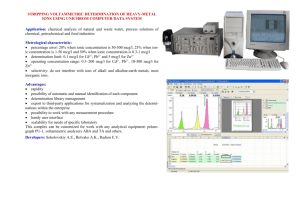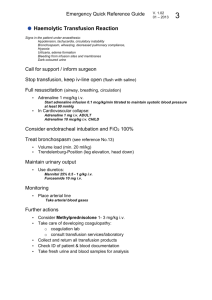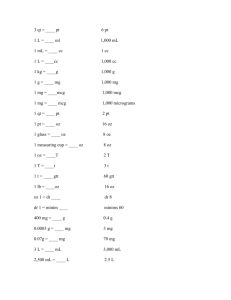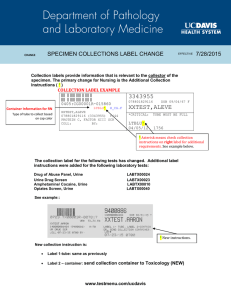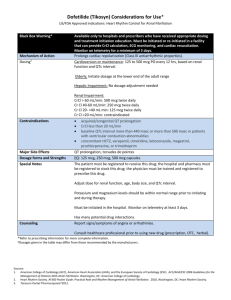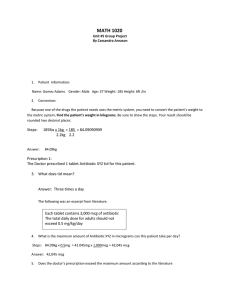Lab Dept: Urine/Stool Test Name: CATECHOLAMINE, FREE
advertisement
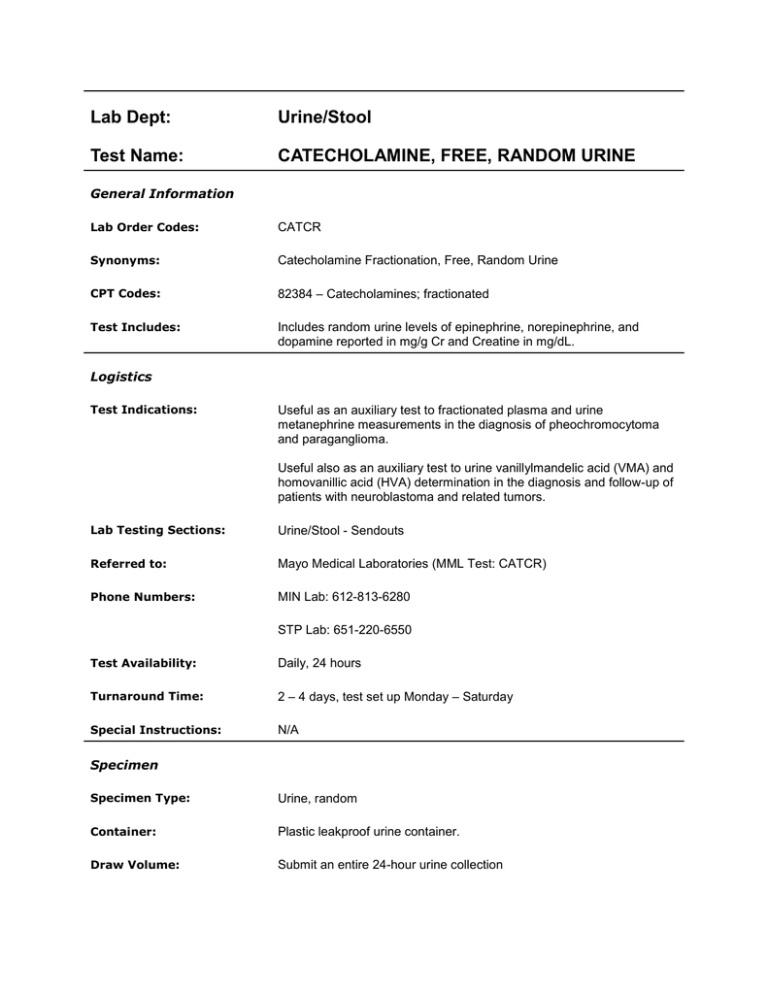
Lab Dept: Urine/Stool Test Name: CATECHOLAMINE, FREE, RANDOM URINE General Information Lab Order Codes: CATCR Synonyms: Catecholamine Fractionation, Free, Random Urine CPT Codes: 82384 – Catecholamines; fractionated Test Includes: Includes random urine levels of epinephrine, norepinephrine, and dopamine reported in mg/g Cr and Creatine in mg/dL. Logistics Test Indications: Useful as an auxiliary test to fractionated plasma and urine metanephrine measurements in the diagnosis of pheochromocytoma and paraganglioma. Useful also as an auxiliary test to urine vanillylmandelic acid (VMA) and homovanillic acid (HVA) determination in the diagnosis and follow-up of patients with neuroblastoma and related tumors. Lab Testing Sections: Urine/Stool - Sendouts Referred to: Mayo Medical Laboratories (MML Test: CATCR) Phone Numbers: MIN Lab: 612-813-6280 STP Lab: 651-220-6550 Test Availability: Daily, 24 hours Turnaround Time: 2 – 4 days, test set up Monday – Saturday Special Instructions: N/A Specimen Specimen Type: Urine, random Container: Plastic leakproof urine container. Draw Volume: Submit an entire 24-hour urine collection Processed Volume: 5 mL (Minimum: 3 mL) urine Collection: Routine urine collection, no preservative Special Processing: Lab Staff: Mix the specimen well, and remove the 5 mL aliquot of urine into a plastic, 13 mL urine tube. Send specimen frozen. Patient Preparation: N/A Sample Rejection: Warm specimens; mislabeled or unlabeled specimens Interpretive Reference Range: Age Epinephrine <6 months <76 mcg/g Cr 6-11 months <61mcg/g Cr 12 – 23 months <40 mcg/g Cr 24 – 59 months <38 mcg/g Cr 5 – 9 years <30 mcg/g Cr ≥10 years <16 mcg/g Cr Age Norepinephrine <3 months <273 mcg/g Cr 3 – 11 months <196 mcg/g Cr 12 – 23 months <140 mcg/g Cr 24 – 59 months <92 mcg/g Cr ≥5 years <54 mcg/g Cr Age Dopamine <6 months 200 – 2675 mcg/g Cr 6 – 11 months 463 – 1933 mcg/g Cr 12 – 23 months 220 – 1654 mcg/g Cr 24 – 59 months 168 – 1156 mcg/g Cr 5 – 9 years 72 – 847 mcg/g Cr ≥10 years 50 – 400 mcg/g Cr Critical Values: N/A Limitations: Many alterations in physiologic and pathologic states can profoundly affect catecholamine concentrations. Any environmental factors that may increase endogenous catecholamine production should be avoided. These include noise, stress, discomfort, body position, and the consumption of food, caffeinated beverages, and nicotine. Caffeine and nicotine effects are short, a few minutes to hours only. Other substances and drugs that may affect the results include: Substances that result in increased release or diminished metabolism of endogenous catecholamines: - Monamine oxidase inhibitors (MOIs - a class of anti-depressants with marked effects on catecholamine levels, particularly if the patient consumes tyrosine rich foods, such as nuts, bananas, or cheese) - Catecholamine reuptake inhibitors including cocaine and synthetic cocaine derivatives, such as many local anesthetics, which also can be anti-arrhythmic drugs (e.g., lidocaine) - Some anesthetic gases, particularly halothane - Withdrawal from sedative drugs, medical or recreational, in particular alcohol, benzodiazepines (e.g., Valium), opioids, and some central acting antihypertensive drugs, particularly Clonidine, but, generally not cannabis or other hallucinogens such as lysergic acid diethylamide (LSD), mescal, or peyote - Vasodilating drugs (e.g., calcium antagonists, alpha-blockers) - Tricyclic antidepressants usually exert a negligible effect Substances that reduce or increase plasma volume acutely (e.g., diuretics, radiographic contrast media, synthetic antidiuretic hormone[e.g., desmopressin 1-deamino-8-d-arginine vasopressin, DDAVP]) Historically, a third category of potentially interfering substances was represented by molecules that are either similar in chemical structure, antibody epitopes, or chromatographic migration pattern to the catecholamines, or have metabolites that can be mistaken for the catecholamines. Our current high-pressure liquid chromatography (HPLC)- based assay is not subject to any significant direct interference of this kind. In most cases, the following drugs do not cause problems with the current assay that cannot be resolved: acetaminophen, allopurinol, amphetamines and its derivatives (methamphetamine, methylphenidate [Ritalin], fenfluramine, methylenedioxymethamphetamine [MDMA] [ecstasy]), atropine, beta blockers (atenolol, labetalol, metoprolol, sotalol), buspirone, butalbital, carbamazepine, clorazepate, chlordiazepoxide, chlorpromazine, chlorothiazide, chlorthalidone, clonidine, codeine, diazepam, digoxin, dimethindene, diphenhydramine, diphenoxylate, dobutamine, doxycycline, ephedrine and pseudoephedrine, fludrocortisone, flurazepam, guanethidine, hydralazine, hydrochlorothiazide, hydroflumethiazide, indomethacin, insulin, isoprenaline, isosorbide dinitrate, L-Dopa, methenamine mandelate (mandelic acid), methyldopa, methylprednisolone, nitrofurantoin, nitroglycerine, oxazepam, pentazocine, phenacetin, phenformin, phenobarbital, phenytoin, prednisone, probenecid, progesterone, propoxyphene, propranolol, quinidine, spironolactone, tetracycline, thyroxine, and tripelennamine. On occasion, when an interference cannot be resolved, an interference comment will be reported. The variability associated with age, gender, and renal failure is uncertain. Methodology: Catecholamines: High Pressure Liquid Chromatography (HPLC) Creatinine: Enzymatic colorimetric assay References: Mayo Medical Laboratories (August 2015)
